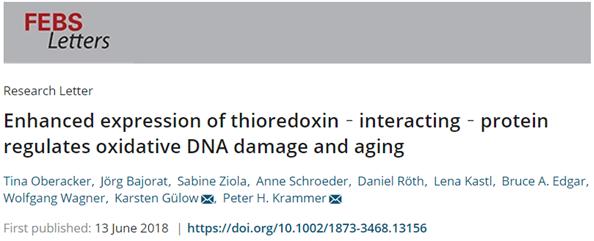On Jun 13th,an article of Enhanced expression of thioredoxin‐interacting‐protein regulates oxidative DNA damage and aging was published on FEBS Letters. Peter H. Krammer and Karsten Gülow from DKFZ are the co authors of the paper.
Oxidative stress
Oxidative stress causes cell and whole organism senescence. If reactive oxygen species accumulate, they damage DNA and alter protein molecules and lipids in cells. Cells will eventually lose their function and die. As time goes on, the tissue is damaged and the body is aging.
Since the 1950s, theories of oxidative stress or accumulation of reactive oxygen species have been around, Krammer said. But so far, the details of the process are still unclear.
In fact, reactive oxygen species (ROS) are not only harmful to the body, they are also crucial to the activation of T cells in the immune system. In the new study, a team led by Krammer and GU low identified a key regulator, a protein called thioredoxin-interacting protein. The protein is responsible for changing the amount of reactive oxygen species from "vital to harmful" to "from vital to harmful" and thus accelerating the aging process.
Key molecules - TXNIP
One way the organism handles harmful reactive oxygen species (ROS) is through an enzyme called thioredoxin-1 (TRX-1). TRX-1 has been shown to play an important role in protecting DNA from oxidative stress and delaying aging. As an antagonist of TRX-1,
TXNIP can inhibit the activity of TRX-1, thus ensuring the retention of reactive oxygen species. The researchers explained.
So, as we get older, will more TXNIP be formed in the body, thereby destroying the protective mechanism against oxidative stress? To answer this question, scientists compared "T cells from volunteer blood over 55" with "T cells from donor blood between 20 and 25 years old" for the first time. The results confirmed that the cells of older volunteers produced significantly more TXNIP. In addition, Krammer also observed similar results in other human cell and tissue types.
At the same time, researchers also found that as age increases, Drosophila also produces more TXNIP. To test whether TXNIP is really associated with aging, they have developed fruit flies that produce significantly more TXNIP than their relatives, and flies that have significantly reduced TXNIP synthesis. The analysis showed that flies that produced more TXNIP had a much shorter life expectancy, while flies that produced less TXNIP had a much longer life expectancy.
Significance
Because TRX-1 and
TXNIP are highly conserved in their evolutionary processes, they are hardly different in Drosophila and humans. It can be assumed that the two proteins play a similar role in Drosophila and humans.
Krammer believes that TXNIP is the key regulator of aging. If the body produces more TXNIP as it ages, it means that TRX-1s protective function will gradually be "turned off", leading to more oxidative stress, damage to cells and tissues, and ultimately death.
"Although scientists have identified hundreds of genes that are somehow involved in the aging process, turning off TXNIP alone is enough to delay aging. This will make it an effective candidate for intervention in aging. " The authors concluded.
Abebio developed ELISA kit
TXNIP ,ROS and TRX-1, with high sensitivity and stability, please contact us if you have any inquiry.
Sean

